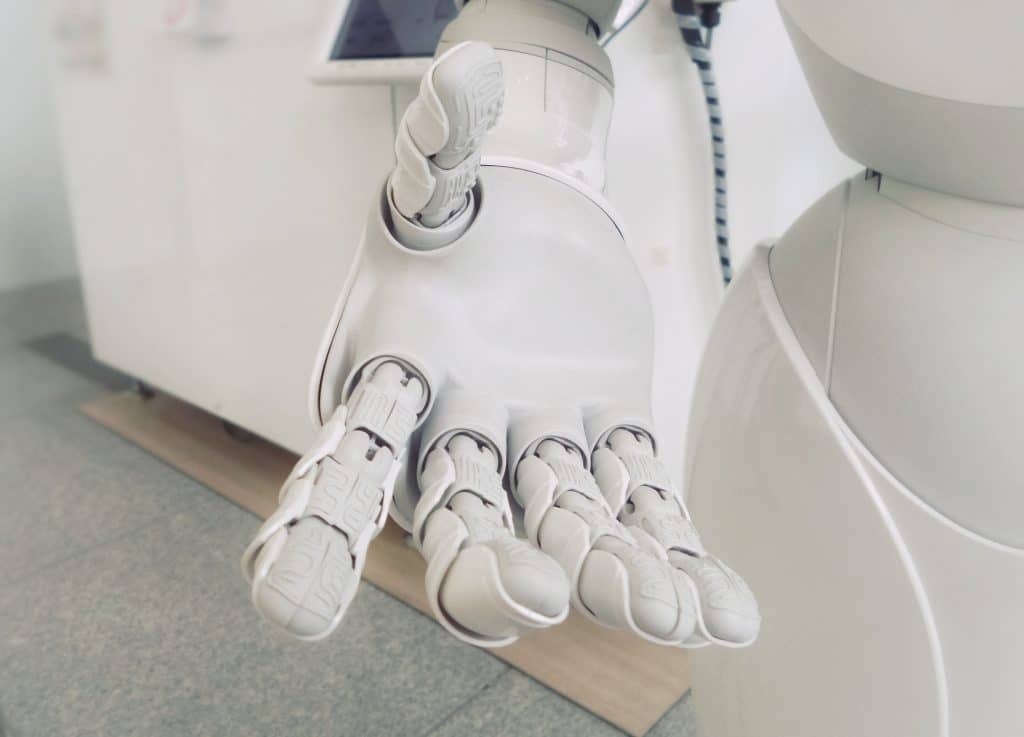
Whether we have noticed it or not, artificial intelligence is already shaping our present. This year has given us new insights into the possible uses and benefits of AI, and the current situation concerning the pandemic has only accelerated its implementation.
Whether it is related to business, healthcare, entertainment, or robotics, AI is affecting the way things are done in any area. Following these developments is not only important, but it’s also fascinating. Artificial intelligence statistics reveal an exciting world of change, so let’s dive into the latest exciting facts and stats about AI.
Top Artificial Intelligence Facts and Figures (Editor’s Pick)
- 58 million is the number of jobs that artificial intelligence will create by 2022.
- 34% of industrial robots sold by 2025 will be able to work alongside humans.
- Only 33% of users are aware of their interactions with AI.
- Artificial intelligence statistics for 2021 show that AI should become the foundation for 80% of emerging technologies by the end of the year.
- Artificial intelligence is more than likely to give a 16% boost to the global economy by 2030.
- 44% of executives state that AI has reduced costs.
- Chatbots found a new purpose during the pandemic.
- Virtual nursing assistants can save 20% of a registered nurse’s time.
Artificial Intelligence Statistics to Know in 2024
1. In 2021, 80% of emerging technologies will have AI foundations.
(Adobe)
Artificial intelligence growth stats continuously emphasize the ever-increasing impact of technology on innovation. The development of technology in the future is directly linked to AI growth. As AI algorithms are ceaselessly learning and evolving, numerous developments in artificial intelligence are expected to come from the AI systems themselves. It certainly gives a brand new meaning to self-improvement!
2. 24% of organizations said they had increased their AI spending after the onset of the pandemic.
(Gartner, McKinsey)
Numerous organizations across all sectors realized its potential in times of crisis. AI was most utilized in the healthcare and pharmaceutical industries, 44% of which increased their AI spending in 2020,
3. The global AI market will grow by 15.2% in 2021.
(IDC)
As the worldwide race to perfect AI technology is picking up the pace, the global AI software market is reflecting these efforts. The potential uses for AI are vast, and its self-improving nature steadily leads us to gain new perspectives on its usefulness. According to August 2021 artificial intelligence growth statistics, the AI market could reach $341.8 billion in 2021 and is expected to exceed $500 billion by 2024.
4. 16% is the boost that AI will give to global economic output by 2030.
(McKinsey)
Artificial intelligence technology has the potential to impact global economic output by enhancing productivity and boosting global GDP by 1.2% annually. Most statistics related to AI conclude that the global economic landscape will change significantly throughout the following decade, thanks to AI development.
5. 285 AI-related companies in the US raised $6.9 billion in the first quarter of 2020.
(VentureBeat)
The state of artificial intelligence today is such that even though the pandemic has slightly slowed down the growing trend, it hasn’t harmed the AI growth significantly. As global funding rose from more than $1 billion in 2013 to $20 billion in 2018, and the growth trend was expected to continue, the first quarter of 2020 promised it would match the previous year at the very least. We will keep following artificial intelligence statistics and keep you informed!
Statistics About Artificial Intelligence in Workforce
6. 20 million manufacturing jobs will be lost to automation by 2030.
(Oxford Economics)
When we talk about the fourth industrial revolution, the most common concern is the possibility of people being replaced by robots. If you are wondering about the number of jobs AI is taking, stats have painted a clear picture. According to the Oxford Economics’ study, AI may be taking over many factory jobs completely if the technology continues to be adopted at the current rate. In the short term, AI factory stats state that robots and AI might take 9% of new jobs by 2025.
7. 25% of US employment will experience high exposure to automation in the coming decades.
(Brookings)
Some of the most shocking statistics about artificial intelligence reveal the rates of automation in the workplace. High exposure to automation means that AI can take on about 70% of tasks. AI industry statistics show that this mainly refers to the food industry workers, short-haul truck drivers, and office workers, such as secretaries. The statistics of AI taking over factory jobs in the US indicate that 36% of US jobs are likely to get medium exposure to automation, while 39% will experience low exposure.
8. Artificial intelligence will create 58 million new jobs by 2022.
(World Economic Forum)
Statistics about AI in the workforce may be frightening, but they aren’t all doom and gloom! While the World Economic Forum report estimates a loss of around 75 million jobs, it also predicts that the added machine workforce will create 133 million jobs, which creates a net gain of 58 million new jobs. According to McKinsey, when it comes to AI and jobs in the US, with sufficient investment, innovation, and economic growth, we can expect positive job growth through 2030 thanks to automation.
9. 83% of employers expect to retrain at least a part of their staff in the next three years to get accustomed to AI.
(McKinsey)
As more and more companies implement AI solutions, they also invest in retraining their employees. Moreover, 38% of employers say that they would retrain more than a quarter of their workers to adjust to the adoption of AI. Employers are becoming more serious about AI as statistics show that nearly six out of ten employers have already retrained some of their employees in the past year.

Artificial Intelligence in Business
10. 70% of all financial services firms are using machine learning in production environments.
(Forbes)
When it comes to artificial intelligence in the financial industry, facts say that AI and machine learning are becoming indispensable. Among other things, they are used to predict risks, advise customers on their financial habits, and detect fraudulent transactions.
11. 54% of companies are planning to implement AI to automate some of their work processes within the next few years.
(Cognilytica)
AI statistics show that most large companies are utilizing artificial intelligence at an accelerating pace. Artificial intelligence assistant statistics point out one of the most dramatic changes, as 52% of public and private sector companies intend to implement conversational systems by 2025.
12. 44% of executives state that AI has reduced costs.
(Forbes)
As AI stats consistently show, companies that employ a well-planned AI strategy see a rise in productivity and revenue and a reduction in costs. The key takeaway here is that the strategy has to be carefully researched as the technology is yet to take its real shape and establish its position on the market.
AI Healthcare Statistics
13. The growth of the AI health market could reach $6.6 billion in 2021.
(Accenture)
The AI health market is attracting more and more attention as governments and industries worldwide are starting to rethink their existing healthcare infrastructures. As AI shows great potential in improving global healthcare, the AI health market grows at around 40% each year. With growing pressure on healthcare workers worldwide, AI medicine statistics can provide invaluable information on how to improve their working conditions and the system’s efficacy.
14. The US healthcare industry can save an estimated $40 billion per year by 2026 by implementing the latest robot-assisted surgery developments.
(Accenture)
Some of the most uplifting AI in healthcare stats elaborate on multiple benefits of robot-assisted surgery. Cognitive robotics can improve the precision of surgical instruments and integrate existing data from previous surgeries. That, in turn, will provide detailed information that could further surgical techniques. Such advancements result in 21% of patient stay reduction. What’s more, with growing amounts of data, robot-assisted surgeries are expected to become even safer and more diverse.
15. Virtual nursing assistants can save 20% of a registered nurse’s time.
(Accenture)
If you cannot decide whether AI is a good thing, statistics like this can certainly help. Virtual nursing assistants can assess patients’ symptoms remotely and inform physicians when medical care is needed, reducing the need for hospital visits and saving precious time. Virtual nursing assistants can also save the US healthcare industry as much as $20 billion by 2026.
16. Incorporating AI applications in US healthcare can yield $150 billion in annual savings by 2026.
(Accenture)
One of the most amazing facts about artificial intelligence is that it offers a number of ways to improve healthcare for everyone permanently. Virtual nursing assistants, robot-assisted surgery, administrative workflow assistance, and fraud detection are some AI solutions that can reduce costs and improve the overall efficiency of the healthcare system.
AI Cybersecurity Statistics
17. 73% of companies are using security products with some form of AI integrated into them.
(Forbes)
While a malicious AI and a virus are different, cybersecurity statistics show that artificial intelligence is being increasingly used as an offensive tool. At the same time, more enterprises realize that it’s crucial to employ it as a defensive tool. AI safety statistics show that up to 84% of companies that see more than 1,000 alerts daily are inclined to rely on products with integrated AI. Also, AI stats show that AI can make decisions much faster than a standard antivirus, which is especially helpful when analyzing large amounts of data.
18. According to 2019 data, 71% of organizations reported planning to spend more on AI and machine learning for cybersecurity.
(Webroot)
More than a quarter of IT professionals in the US and Japan believe that their companies could be doing more to protect their data. When it comes to AI hacking, statistics show that 84% of IT professionals believe that artificial intelligence and machine learning are used to conduct cyberattacks and that these technologies are also key to keeping data secure.
19. Costs associated with deepfakes were projected to surpass $250 million in 2020.
(Forrester Research)
Luckily, the 2021 update from Forrester concluded that the costs were not as dramatic. Nonetheless, if we were looking for statistics against AI, deepfakes statistics would most certainly be among our top candidates.
Deepfakes are a way of using artificial intelligence and natural language generation technology to fabricate videos that are often indistinguishable from the real ones. There is justified concern that anyone with a powerful enough computer and access to the right AI algorithm can misuse the technology.
20. 51% of companies use AI as their primary threat detection, prediction, and response tool.
(Forbes)
Artificial intelligence statistics show that most companies use AI to detect threats, whereas a smaller number of them also use it for threat prediction and response. As cybersecurity challenges grow with the advent of technology, more and more AI projects focus on prediction and response to face cybersecurity threats.
21. 43% of security decision-makers say they analyzed all cloud security incidents encountered over the last year.
(Symantec Enterprise)
Almost half of them also report the inability to manage all the alerts their companies have received. This is where AI with its data recognition speed and response time comes into play! Moreover, as we’ve gathered from multiple AI and machine learning statistics, combining the two with other security measures can improve cloud security significantly.

Interesting Facts About Artificial Intelligence
22. 34% of industrial robots sold by 2025 will be able to work together with humans.
(Robotic Industries Association)
While many artificial intelligence statistics tend to cause concern, some are just plain exciting to think about! If your new colleagues seem a bit wiry, they just might be cobots or collaborative robots.
This cooperation comes in handy now with the pandemic causing major disruptions. For instance, BrainCorp, a software company that produces software for floor cleaning robots, says that the autonomous floor cleaning robots are doing about 8,000 hours of work that would have otherwise been done by essential workers.
AI robots statistics around the world show that the pandemic has increased the rates of AI implementation, e.g., the previously mentioned floor cleaning robots are doing 13% more work now than before the pandemic started.
23. AI helped solve another key issue in medicine and biology, predicting the 3D shape of a protein.
(Nature)
Even though it was an eventful and stressful year, this is one of the most important artificial intelligence facts from 2020 that you should try to remember. A deep-learning network called AlphaFold managed to predict the 3D shape of a protein, which determines what the protein does and how it works. Highly-accurate predictions provided by AI could have a huge impact on the fields of medicine, research, and bioengineering.
24. Only 33% of people are aware that they’re already using AI platforms.
(Venture Harbour)
One of the most interesting artificial intelligence facts is that we often don’t know that we’re interacting with artificial intelligence in the first place! Most people think that the technology they use does not employ any form of artificial intelligence. However, stats on AI use show that 77% of people use technology with integrated AI. It frequently comes disguised as a useful virtual assistant, chatbot, or navigation app, so nothing feels out of the ordinary!
25. As many as 95% of all customer interactions in 2025 will happen through channels supported by AI.
(Microsoft)
AI customer service statistics show that the market will not only grow in numbers but that it will also become more creative. AI customer service assistants can help customers receive the information they need even after the workday has ended. What’s more, they can also provide service that would otherwise be impossible. For example, virtual makeup try-ons are slowly becoming the standard for cosmetic companies, allowing you to try out different products based on nothing but a photo of your face.
26. Chatbots found a new purpose during the pandemic.
(Nature, Journal of the American Medical Informatics Association)
Chatbots have been helping people self-assess their symptoms and understand their level of risk of getting a COVID-19 infection. They have also been providing people with useful information and advice on preventive measures. Interestingly, users of chatbots described these interactions as the same or more positive interactions with human agents.
Why You Should Follow the Development of AI
It’s not an overstatement that the development of AI will change the course of human history. The CEO of Google, Sundar Pichai, said that he thinks of it as something “more profound than electricity or fire.” AI development has already changed how we interact with the world, including even the most mundane tasks, such as looking for directions or finding a TV show to watch.
As you can see from our artificial intelligence statistics, AI is the technology to follow. It doesn’t matter if you’re interested in business, finance, healthcare, politics, or anything else. Understanding the important facts about AI will keep you (at least) one step ahead.
FAQ
What is statistical artificial intelligence?
Artificial intelligence and statistics have a long-standing history. Statistical (or probabilistic AI) is a type of AI that operates by recognizing patterns and inducing trends according to these patterns. Its thought is considered inductive, rather than deductive: it learns patterns and predicts what might happen next.
Statistical AI uses statistical methods to recognize patterns. and it can often be used for product recommendations or asset management in finance.
What percentage of companies are using AI?
The latest IBM research states that 34% of businesses in the US, EU, and China have already incorporated AI into their business, while 39% are currently in the process of doing so. Around 40% of companies are employing pre-built AI apps, such as chatbots and virtual agents. Most companies that have an AI strategy are large companies with over 100,000 employees. According to artificial intelligence stats for 2019, only 23% of businesses were using AI. However, due to the pandemic, more companies incorporated AI as a part of their service in 2020, and the adoption of AI is projected to keep growing in 2021, too.
What are some examples of artificial intelligence?
Before we show you some famous examples of AI, we need to clarify a common misconception regarding virtual intelligence vs. artificial intelligence. The main difference between virtual and artificial intelligence is that virtual intelligence only does what it is designed to do, while artificial intelligence learns how to interact with the world and make decisions based on training.
Real artificial intelligence covers a wide range of products and services, and its potential uses are only going to multiply. The current uses of artificial intelligence include everything from adorable Roombas that use AI to find their way around the room to virtual assistants such as Alexa and Siri. The usage of AI goes all the way to autonomous vehicles, automated manufacturing machines, and smart surveillance technology.
What are the advantages and disadvantages of AI?
The consequences of any technology always depend on the way we choose to use it. However, there are concerns about AI use that make this technology especially controversial. Take a look at the main advantages and disadvantages of AI and decide for yourself.
Advantages:
- Taking over repetitive tasks and leaving the complex, more satisfactory work to humans
- Helping in situations that would be too risky or impossible for people to deal with
- Being able to make decisions and perform tasks with more speed and precision
- Improving healthcare and reducing the burden on health workers
- Continually improving itself and helping with new inventions
- Providing us with new insights on complex global issues by analyzing large amounts of data
Disadvantages:
- Leads to unemployment as it will affect the majority of occupations
- The high cost of implementation and maintenance
- Can replicate a system of ethics and values, but cannot think outside of the box
Sources:
- Accenture
- Adobe
- Brookings
- Cognilytica
- Forbes
- Forbes
- Forbes
- Forrester Research
- Forrester Research
- Gartner
- IDC
- Journal of the American Medical Informatics Association
- McKinsey
- McKinsey
- McKinsey
- Microsoft
- Nature
- Nature
- Oxford Economics
- Robotic Industries Association
- Symantec Enterprise
- VentureBeat
- Venture Harbour
- Webroot
- World Economic Forum


